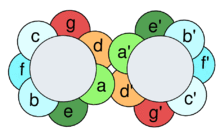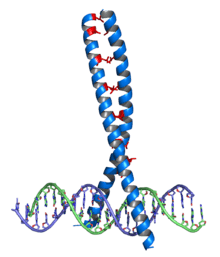Leucine zipper

A leucine zipper, aka leucine scissors,[1] is a common three-dimensional structural motif in proteins. These motifs are usually found as part of a DNA-binding domain in various transcription factors, and are therefore involved in regulating gene expression. Leucine zippers are found in both eukaryotic and prokaryotic regulatory proteins, but are mainly a feature of eukaryotes.
The leucine zipper is a super-secondary structure that functions as a dimerization domain, and its presence generates adhesion forces in parallel alpha helices.[2] A single leucine zipper consists of multiple leucine residues at approximately 7-residue intervals, which forms an amphipathic alpha helix with a hydrophobic region running along one side. This hydrophobic region provides an area for dimerization, allowing the motifs to "zip" together. Furthermore, the hydrophobic leucine region is absolutely required for DNA binding.
Structure

The main feature of the leucine zipper domain is the predominance of the common amino acid leucine at the d position of the heptad repeat. Leucine zippers were first identified by sequence alignment of certain transcription factors that identified a common pattern of leucines every seven amino acids. These leucines were later shown to form the hydrophobic core of a coiled coil.
Each half of a leucine zipper consists of a short alpha-helix with a leucine residue at every seventh position. The standard 3.6-residues-per-turn alpha-helix structure changes slightly to become a 3.5-residues-per-turn alpha-helix. Known also as the heptad repeat, one leucine comes in direct contact with another leucine on the other strand every second turn.
The bZIP family of transcription factors consists of a basic region that interacts with the major groove of a DNA molecule through hydrogen bonding, and a hydrophobic leucine zipper region that is responsible for dimerization.
Biology
Leucine zipper regulatory proteins include c-fos and c-jun (the AP1 transcription factor), important regulators of normal development, as well as myc family members including myc, max, and mdx1. If they are overproduced or mutated in a vital area, they may generate cancer. These proteins interact with the DNA as dimers (homo- or hetero-) and are also called basic zipper proteins (bZips).
References
- ↑ David M. Glick, ed. (1997). "Leucine scissors". Glossary of Biochemistry and Molecular Biology (Revised ed.). London: Portland Press.
- ↑ Landschulz WH, Johnson PF, McKnight SL (1988-06-24). "The leucine zipper: a hypothetical structure common to a new class of DNA-binding proteins". Science 240 (4860): 1759–1764. doi:10.1126/science.3289117. PMID 3289117.
External links
- Leucine zippers at the US National Library of Medicine Medical Subject Headings (MeSH)
| |||||||||||||||||||||||||||||||||||||||||||||||||||||||||||||||||||||||||||||||||||||||||||||||||||||||||||||||||||||||||||||||||||||